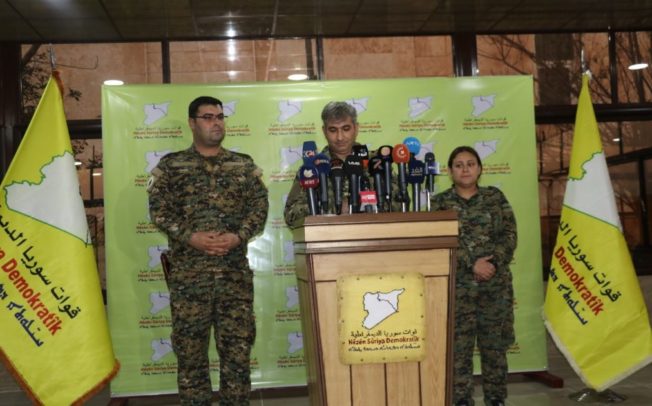Washington Kurdish Institute
February 18, 2019
Despite the risks to America’s national security and interests including the reemergence of the terror groups, the strengthening and expansion of the Assad dictatorship, the empowerment of Russia and Iran within Syria, and the growth of jihadist groups openly supported by Turkey, it appears that President Trump is determined to push ahead with his decision to rapidly withdraw U.S. troops from Syria. Recently, the United Nation Counter-Terrorism Chief warned that ISIS still have 18,000 terrorists, including some 3,000 foreign fighters, within their ranks. In addition to a number of U.S. military generals and members of the intelligence community, the U.S. Central Command Commander General Votel also warned of the threats posed by ISIS. The U.S. withdrawal decision provided an instant boost to the Syrian regime backed by Russia, while, on the other side, Turkey is seeking to take advantage of the situation to attack the Kurdish forces who were fighting ISIS over the last few years.
The U.S-backed Syrian Democratic Forces (SDF) are currently in the process of finishing the last of the “caliphate” of ISIS (i.e., the territory controlled by the terrorist group), but the long-term fate of the SDF remains unclear.
How are the SDF and why do they matter?
In 2014, when ISIS declared the establishment of an “Islamic State”, the Kurdish forces in Syria, called the People’s Defense Units (YPG) fought them, unlike the Islamist opposition groups in the country who often surrendered to the terror group. In the brutal battle to defend the Kurdish city of Kobani, the YPG fiercely resisted an all-out onslaught by ISIS, which led the global coalition against ISIS, led by the U.S., to approach them and provide them with air support against ISIS terrorists. After capturing swathes of land across Syria and Iraq, Kobani was the first place where ISIS was defeated and pushed back. While the YPG defied doubters and liberated Kobani, other Syrian opposition groups then backed by the United States handed over the weapons and other equipment received from the U.S. to al Qaida after being trained by the Pentagon. In order to stop ISIS from thriving and controlling more territory, the U.S.-led coalition agreed with the Kurds to form a secular, multi-ethnic fighting force in Syria from among those who were willing to defend their land. From September 2014 to June 2015, the YPG and few moderate Syrian opposition groups, in partnership with the U.S. led coalition, were able to defeat ISIS in various battles. On June 25, 2015, the SDF was officially formed, including Kurdish, Arab and Christian men and women, and continued fighting ISIS in Syria.
After four years of fighting, the SDF nearly finished clearing ISIS from Syria, though at the cost of the lives of thousands of its members. In some cases, SDF campaigns aimed at liberating certain areas took months, including:
- The Revenge for Elin and Cudi Campaign, which cleared tens of villages, mostly belonging to Christians who were expelled from their lands by ISIS terrorists. The two-phased campaign resulted in the elimination of more than 1,500 ISIS terrorists in seven weeks of clashes
- The Liberation of Manbij, also known as the Martyr Faisal Abu Leyla Campaign, which lasted three and a half months (May 2016-August 15, 2016) and ultimately resulted in the liberation of the city of Manbij and its countryside by the SDF. Hundreds of airstrikes by the U.S.-led coalition aided the SDF in neutralizing more than 2,500 ISIS terrorists. The SDF lost nearly 400 fighters, while 1,112 were wounded. Manbij was a strategic loss for ISIS terrorists, as they were launching and planning attacks against the west from the city. Thousands of documents and plans of the terror group were confiscated in Manbij.
- The Wrath of Euphrates Operation to liberate Raqqa, the de facto capital of the ISIS terrorist group. Previous SDF advances proved their effectiveness and offered a solution for the war against ISIS in Syria. The battle for Raqqa was the longest campaign in this struggle, due to the defenses that ISIS had prepared over a period of two years as well as their concentration of fighters and resources in the city. On November 5, 2016, the multi-phased campaign to liberate Raqqa began. By October 20, 2017, Raqqa was free and the so-called “caliphate” no longer had any sort of capital. Over the course of almost a year, the SDF lost 793 fighters, including commanders, while 1,658 were wounded. In the liberation of Raqqa, 32,930 square kilometers were liberated and half million people were rescued from ISIS. The heaviest losses came to ISIS – 5,682 terrorists were killed and 1,113 were detained. including tens of foreign terrorist fighters from Europe and the U.S.
- The Jazeera Storm military campaign, aimed at eliminating the remnants of terror group’s territorial control. The SDF launched its final battle against ISIS in the Eastern Euphrates area in September 2017. Tens of towns and villages were liberated in Deir ez-Zour province, ultimately ending the existence of ISIS as a entity with any real control over significant territory in Syria. Thousands of terrorists were killed and hundreds surrendered.
The SDF fighting against the terror groups never stopped in between the military campaigns. The SDF, and mainly the Kurdish forces within the SDF, lost nearly 5,000 fighters including hundreds due to attacks by Turkey and their jihadist proxy groups in the Afrin region.
The SDF’s effectiveness goes beyond military accomplishment – indeed, the group has also proven effective in stabilizing areas after liberation by by helping to set up local councils to govern and protect these areas. It is a testament to their ability to maintain stability that areas under the SDF control have hosted over a million of internally displaced persons (IDPs) and refugees.
On February 17, 2019, the SDF held a meeting attended by a number of its commanders to address the control of territory following the defeat of ISIS. The SDF then announced several points including their military strategy, Turkey’s threats, discussions with the Assad regime, and their deployment. The SDF statement following this meeting included, among other things the following priorities with respect to security: “eliminate the secret military organization of sleeping cells, through precise military and security campaigns, with the support of the international coalition forces”, and “the drying up of the social, intellectual and economic ground which [ISIS] depends on for the continuity of its existence. The SDF and the Pentagon are well aware of the ongoing threat posted by ISIS and their potential to reemerge in some form and destabilize Syria through terror attacks. However, the ability of the SDF to achieve this goal will be weakened if the U.S. pulls their troops from Syria. If the SDF is distracted by the attacks threatened by Turkey, and perhaps by a full-scale invasion by Turkish forces, terror groups will be given a perfect opportunity to regroup and reemerge. The SDF itself will be in danger as an entity, as the Syrian regime and Russia will want some if not all of these U.S.-trained forces to join Syria’s military. Despite the SDF’s willingness to hold serious talks with the Assad regime for a peaceful solution, but it appears that Assad wants to retake control all the areas under the SDF control, bringing the Kurds of Syria back to the dark days experienced prior to the current conflict.
A suggestion by the U.S. to the European countries to replace U.S. troops with their forces was recently revealed by Senator Lidensy Graham. While this sounds reasonable, it would nonetheless still require a small U.S. presence in Syria to lead and coordinate with the European nations, especially with respect to logistical support. Other than protecting the U.S. national security interest, the U.S. troops in Syria helped to maintain peace and stability in the region, keeping it free of ISIS, Turkey-backed groups, and other jihadists. Indeed, U.S. presence provided the Kurdish forces and their allies with a de facto no fly zone since Turkey and others would not attempt to attack the SDF and the Kurdish region in the presence of the U.S. troops.
Since 2014, the U.S. has enjoyed great military success in Syria in the fight against terrorism, and also successfully built a trustworthy local militarily force that is friendly to America and capable of credibly facing future terrorist threats. Tens of millions of dollars were spent on the SDF, but the future of the group will remain unclear unless President Trump decides to modify his decision to withdraw U.S. troops and chooses to coordinate with America’s allies to ensure the lasting defeat of terrorism.

